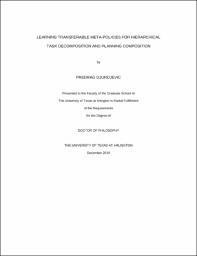
ATTENTION: The works hosted here are being migrated to a new repository that will consolidate resources, improve discoverability, and better show UTA's research impact on the global community. We will update authors as the migration progresses. Please see MavMatrix for more information.
Show simple item record
| dc.contributor.advisor | Huber, Manfred | |
| dc.creator | Djurdjevic, Predrag | |
| dc.date.accessioned | 2020-06-12T22:15:45Z | |
| dc.date.available | 2020-06-12T22:15:45Z | |
| dc.date.created | 2020-05 | |
| dc.date.issued | 2019-12-16 | |
| dc.date.submitted | May 2020 | |
| dc.identifier.uri | http://hdl.handle.net/10106/29100 | |
| dc.description.abstract | In real world scenarios where situated agents are faced with dynamic, high-dimensional, partially observable environments with action and reward uncertainty, the traditional states space Reinforcement Learning (RL) becomes easily prohibitively large for policy learning. In such scenarios, addressing the curse of dimensionality and eventual transfer to closely related tasks is one of the principal challenges and motivations for Hierarchical Reinforcement Learning (HRL). The prime appeal of hierarchal and particularly recursive approaches is in effective factored state, transition and reward representations which abstract out aspects that are not relevant to subtasks and allow potential transfer of skills which represent solutions to potential task subspaces. With the advent of deep learning techniques, a range of techniques for representation learning have become available for a range of problems, mostly in supervised learning applications, however, relatively little has been applied in the context of hierarchical Reinforcement Learning where different time scales are important and where limited access to large training data sets and reduced feedback has made learning on these structures difficult. Moreover, the addition of partial observability and the corresponding need to encode memory through recurrent connections further increase this complexity and very limited work in this direction exists.
This dissertation investigates the use of recurrent deep learning structures to automatically learn hierarchical state and policy structures without the need for supervised data in the context of Reinforcement Learning problems. In particular, it proposes and evaluates two novel network architectures, one based on Conditional Restricted Boltzmann Machines (CRBM) and one using a Multidimensional Multidirectional Multiscale LSTM network. Experiments using a very sparsely observable version of the common taxi domain problem show the potential of the architectures and illustrate its ability to build hierarchical, reusable representations both in terms of state representations and learned policy actions. | |
| dc.format.mimetype | application/pdf | |
| dc.language.iso | en_US | |
| dc.subject | Reinforcement learning | |
| dc.subject | Q learning | |
| dc.subject | DQN | |
| dc.subject | Long short term memory | |
| dc.subject | Conditional restricted boltzmann machines | |
| dc.subject | Transfer learning | |
| dc.subject | POMDP | |
| dc.title | LEARNING TRANSFERABLE META-POLICIES FOR HIERARCHICAL TASK DECOMPOSITION AND PLANNING COMPOSITION | |
| dc.type | Thesis | |
| dc.degree.department | Computer Science and Engineering | |
| dc.degree.name | Doctor of Philosophy in Computer Science | |
| dc.date.updated | 2020-06-12T22:15:46Z | |
| thesis.degree.department | Computer Science and Engineering | |
| thesis.degree.grantor | The University of Texas at Arlington | |
| thesis.degree.level | Doctoral | |
| thesis.degree.name | Doctor of Philosophy in Computer Science | |
| dc.type.material | text | |
Files in this item
- Name:
- DJURDJEVIC-DISSERTATION-2020.pdf
- Size:
- 1.061Mb
- Format:
- PDF
This item appears in the following Collection(s)
Show simple item record


